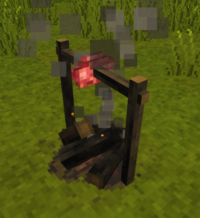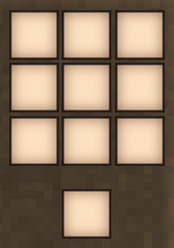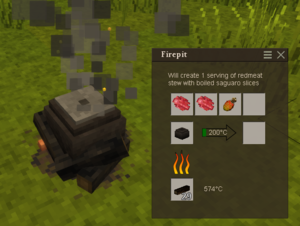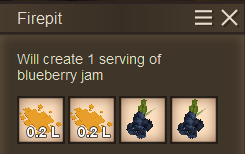Kochen
Nährstoffe und Sättigung
Aktuelle Nährstoff- und Sättigungswerte können im Charakterfenster angesehen werden, als Voreinstellung auf 'C'.
Sättigung
Die Sättigung des Spielers gibt an, wie hungrig dieser ist - oder sozusagen, wie viele Kalorien noch zum anfeuern überig sind. Angezeigt wird dies durch die grüne Leiste rechts überhalb der Hotbar, mit einem Maximalwert von 1500. Der Sättigungswert fällt automatisch mit der Zeit, selbst wenn der Spieler AFK ist und sich nicht bewegt. Bestimmte Aktionen, wie Rennen, das Tragen bestimmter Ausrüstung (z.B. fast alle Rüstungen) oder bestimmte Zustände (wie das Regenerieren von Lebenspunkten) beschleunigen diesen passiven Verbrauch jedoch. Falls der Sättigungswert auf null fällt, beginnt der Spieler zu verhungern - dies bedeuted man erleidet Schaden, bis man schließlich stirbt. Das Essen beliebiger Lebensmittel stellt Sättigung wieder her, entsprechend der in der Beschreibung angegebenen Werte.
Nährstoffe
Während Sättigung eine grundsätzliche Voraussetzung zum Überleben darstellt, bieten die Nährstoffe eine Möglichkeit, Boni durch das Essen verschiedener Lebensmittel zu erhalten, anstatt sich immer nur auf ein und das selbe zu verlassen. Die Nährstoffwerte des Spielers können in vier Kategorien unterteilt werden, welche im Charakterfenster überprüft werden können: Eiweiß, Gemüse, Getreide und Obst. Wenn der Spieler Sättigung durch das Essen eines Lebensmittels gewinnt, erhöht sich dadurch auch die Leiste der Nährstoffgruppe, zu welcher das Essen gehört. Mahlzeiten welche aus mehreren Zutaten gekocht wurden, können mehrere Nährstoffe gleichzeitig erhöhen. So wie Sättigung verringern sich auch die Nährstoffwerte mit der Zeit. Um alle vier Nährstoffwerte am Anschlag zu halten sollte man sich also ausgeglichen ernähren.
Wenn die Nährwert Leisten aufgefüllt werden, erhöhen sich die maximalen Lebenspunkte des Spielers. Man startet mit 15 Lebenspunkten, und jede voll ausgefühllt Nährwert Leiste kann weitere 2.5 LP hinzufügen - bis zu maximalen 10 extra Lebenspunkten. Dieser Bonus ist sehr hilfreich, sobald man sich in die tiefsten Tiefen der Welt begibt und sich den dortigen Monstern stellt.
Einfache Speisen
Zu Beginn des Spieles und ohne nennenswerte Infrastruktur, hat der Spieler nur eine kleine Auswahl an roh essbarem, gesammeltem oder gejagtem Essen zur Auswahl. Man sollte sich jedoch nicht zu lange auf dieses verlassen, denn sobald geerntet, sind natürliche Rohstoffe entweder für immer abgebaut oder brauchen sehr viel Zeit zum Nachwachsen.
Die folgende Tabelle zeigt alle Lebensmittel, die roh gegessen werden können:
| Lebensmittel | Sättigungswert | Kategorie | Notizen |
|---|---|---|---|
| Preiselbeeren | 60 | Obst | |
| Blaubeeren und Johannesbeeren* | 80 | Obst | |
| Honig Schüssel* | 60 | Obst | Hergestellt. Stellt bei Verzehr 0.5 LP wieder her. |
| Saguaro Frucht | 60 | Obst | Stellt bei Verzehr 1 LP wieder her. |
| Flachs Getreide | 30 | Getreide | |
| Reis, Roggen oder Dinkel Getreide | 60 | Getreide | |
| Steinpilz und Feldpilz | 80 | Gemüse | |
| Fliegenpilz | 80 | Gemüse | Schädigt den Spieler um 10 Lebenspunkte (!) wenn konsumiert. |
| Karotten, Zwiebeln, Pastinaken, Steckrüben | 100 | Gemüse | |
| Kohl | 300 | Gemüse | |
| Kürbis, Scheibe | 120 | Gemüse | Crafted. |
| Kürbis, ganz | 480 | Gemüse | |
| Fettklumpen | 200 | Eiweiß | |
| Klassisches Rindfleisch | 280 | Eiweiß | Seltene Beute aus Ruinen. Stellt bei Verzehr 2 LP wieder her. |
- Johannesbeeren schließen rote, schwarze und weiße Johannesbeeren ein.
- Um Schüsseln mit Honig herstellen zu können, muss der Spieler mit der Bienenzucht starten.
Einfaches Kochen
Die erste Gelegenheit, besseres Essen herzustellen, ergibt sich mit der Feuerstelle. Eine geringe Anzahl gesammelter oder gejagter Zutaten kann zur Verarbeitung direkt in die Feuerstelle gegeben werden. Außerdem wird sie genutzt um aus Teig Brot zu backen.
Die folgende Tabelle zeigt alle Lebensmittel, die gebraten gegessen werden können:
| Item | Satiety | Category | Notes |
|---|---|---|---|
| Bushmeat | 120 | Protein | |
| Redmeat | 280 | Protein | |
| Poultry | 200 | Protein | |
| Cooked egg | 160 | Protein | Recipe currently defunct. |
| Cooked cattail root | 100 | Vegetable | |
| Flax bread | 160 | Grain | Crafted. |
| Rye or spelt bread | 300 | Grain | Crafted. |
| Rice bread | 330 | Grain | Crafted. |
Making Bread
Despite the deceptively simple baking process, making bread requires some setup in order to produce the dough. A bucket and a quern must be available, both of which require metal tools to craft. Additionally, a farm is required to consistently supply useful amounts of grain, as wild crops are nonrenewable, mature extremely slowly, and are susceptible to being eaten by animals.
In return, bread is one of the best ways to process grains that exists in the game, with an at least five-fold yield multiplier compared to eating the raw grain.
To create bread dough, prepare flour using a quern to grind grain.
Open the quern GUI and add grain into the input slot on the left of the quern.
- Hold
interact on the top of the quern to grind the grain into flour, which will appear in the output slot on the right of the quern.
During later stages of the game, a windmill may be used to drive the quern.
- In the crafting grid, combine a bucket of water and flour to create dough. Each flour item will consume one unit of water from the bucket.
Advanced Cooking
Advanced cooking allows the player to make meals out of multiple ingredients, which can potentially supply multiple nutrition groups at he same time. Cooking increases the food values of all ingredients used, and provides additional benefits and convenience. A single pot can potentially contain thousands of satiety points; meals can be kept fresh for very long times in sealed crockpots; eating meals will outright halt satiety loss for a time; and the player will never waste any food from a meal when it provides more satiety than they need. Instead, they simply leave a partially-eaten serving that can be finished at a later time.
To begin, craft at least one bowl and one claypot using the clay forming mechanic, and fire them like all ceramics in a firepit. Placing the fired claypot into the fire pit input slot (upper left) will open up an additional four-slot inventory above the input slot, in which ingredients can be combined into one of the five available meal types. The meal type players create is determined by which two "required" ingredients are placed into the claypot first.
- To create one serving of any meal: place one of each required item into two separate claypot slots (this defines the meal type). For example, a porridge requires "two grain", so a player must add two individual pieces of grain in any two input slots in the claypot. Placing two grain in one input slot of the claypot will not create a porridge. Adding "optional" ingredients in the other two input slots of the claypot will increase the nutrition value and satiation of the meal depending on which items are added. When a valid meal recipe (combining correct ingredients) is placed into the input slots, a message will appear in the claypot dialog box informing players about what type of meal will be created after cooking.
- To cook multiple servings of a meal: increase the number of ingredient items added to all slots equally. The claypot allows players to cook up to 6 servings of any meal at a time. When creating multiple servings all the items in the input slots must be increased by the same amount, or the food will not cook!
- To fill a bowl: A bowl holds one meal portion and may be filled from a claypot or food storage crock. To fill a bowl, place the container of cooked food onto a solid surface. With the empty bowl in the active hand use RMB on the claypot or crock. Bowls and crocks may be filled with meals while the claypot is in the firepit. Bowls of food may be carried in player inventories, stored in stationary containers, and placed on shelves. Bowls cannot be filled from crocks on shelves.
- To eat a meal: Food may be consumed from a filled bowl. With the filled bowl in an active hotbar slot, eat using RMB. Players will eat until full, which may leave partial portions of food in the bowl.
- To store meals: Four portions of any cooked meal can be stored in an empty crock. Place the pot onto the ground or table and right click the pot with an empty crock to transfer meals to the storage crock. Storage crocks may be sealed for long term storage using fat or wax in the crafting grid, Crocks may also be carried in player inventories, stored in stationary containers, and placed on shelves.
Advanced Cooking Recipes
| Advanced Recipes | Meat Stew | Vegetable Stew | Porridge | Soup | Jam |
|---|---|---|---|---|---|
| Required Ingredients | 2 Poultry or Red meat | 2 Vegetables or Beans | 2 Grain | 1 Vegetable (Fresh) + 1 Water* | 2 Fruit + 2 Honey* |
| Optional Protein | 0 - 2 Poultry, Red meat, Egg or Beans | 0 - 2 Soy beans (pickled or fresh) | 0 - 1 Poultry, Red Meat or Egg | ||
| Optional Vegetable | 0 - 2 Vegetable (pickled or fresh) | 0 - 2 Vegetable (pickled or fresh) | 0 - 2 Vegetable (pickled or fresh) | 0 - 2 Vegetable (pickled or fresh) | |
| Optional Grain | 0 - 2 Grain | ||||
| Optional Fruit | 0 - 1 Fruit, Honey* | 0 - 2 Fruit | |||
| Optional Honey | 0 - 1 Honey* |
- Add water or honey with a filled bucket. Use LMB to add one portion, RMB to remove one portion.
Advanced Cooking Food Values
The satiation received from eating meals is equal to the sum of its parts. The ingredients added to create the meal determine how much satiation and which class of nutrition a player receives. In addition, the food values of most ingredients are increased via cooking, as shown in the table below. Only pickled ingredients remain unchanged, providing the same amount of value in a meal as they would when eaten individually.
Note: for every 100 satiation filled by consuming a meal, an additional 30 seconds passes before the player's satiety bar starts dropping again for any reason other than health regeneration. Consuming a large meal can result in more than five minutes of completely free sprinting, heavy armor wearing, or other strenuous tasks.
| Protein | Satiation in Meal | Vegetable | Satiation in Meal | Grain | Satiation in Meal | Fruit | Satiation in Meal |
|---|---|---|---|---|---|---|---|
| Soy Bean | 240 | Carrot, Parsnip, Onion, Turnip | 150 | Flax grain | 120 | Currants* | 120 |
| Egg | 200 | Cabbage | 450 | Rice grain | 280 | Blueberry | 120 |
| Poultry, cured or fresh | 375 | Pumpkin slice | 180 | Rye grain | 240 | Cranberry | 90 |
| Redmeat, cured or fresh | 420 | Pumpkin, whole | 720 | Spelt grain | 240 | Saguaro fruit | 90 |
| Mushrooms* (Bolete, Field, Fly agaric) | 120 | Honey | 80 |
- Ingredients not listed in this table cannot be used in meals. Pickled variants of listed ingredients can be used, but are worth less.
- Currants include black currant, red currant, and white currant berries.
- Mushrooms can only be secondary ingredients. They can be added to valid meals, but cannot make a valid meal themselves.
- Ingredients that restore player health when eaten raw, such as saguaro fruits or honey, lose this benefit when cooked.
However, cooking a fly agaric mushroom does not remove its harmful effects - the meal will still damage the player!
| {{{title}}} | |
|---|---|



